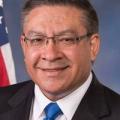Representative Salud Carbajal, a veteran, was born in Mexico and emigrated as a child with his family to Arizona and later Oxnard, CA. After high school, Carbajal attended the University of California at Santa Barbara (UCSB) and went on to obtain his Master's Degree in Organizational Management from the Fielding University. Carbajal spent eight years in the United States Marine Corps, including active duty during the 1991 Gulf War.
Carbajal was elected to the 24th District in 2017 after serving on the Santa Barbara County Board of Supervisors for 12 years. According to campaign materials, he is running for reelection on a platform that promotes a robust Central Coast through investments in infrastructure and housing, renewable energy and environmental protections, and workforce development.
Salud serves on the House Committee on Armed Services, the House Committee on Agriculture, and the House Committee on Transportation and Infrastructure, where he was elected to serve as the Vice Chair. As part of his commitment to renewable energy, Salud’s first act in Congress was to introduce the California Clean Coast Act, which would ban future offshore oil and gas drilling on California’s coast. He also secured $1 million for the Santa Barbara Veterans Treatment Courts and has introduced legislation to combat veteran homelessness.
Representative Carbajal is being challenged by Andy Caldwell (R), a conservative radio host, and Kenneth Young (NPP). Based on our analysis, Rep. Salud Carbajal has consistently demonstrated a commitment to progressive issues, from protecting the environment to ensuring DACA protections remain in place.
According to our analysis, Rep. Carbajal is the strongest choice for progressive leadership in this district.
Representative Salud Carbajal, a veteran, was born in Mexico and emigrated as a child with his family to Arizona and later Oxnard, CA. After high school, Carbajal attended the University of California at Santa Barbara (UCSB) and went on to obtain his Master's Degree in Organizational Management from the Fielding University. Carbajal spent eight years in the United States Marine Corps, including active duty during the 1991 Gulf War.
Carbajal was elected to the 24th District in 2017 after serving on the Santa Barbara County Board of Supervisors for 12 years. According to campaign materials, he is running for reelection on a platform that promotes a robust Central Coast through investments in infrastructure and housing, renewable energy and environmental protections, and workforce development.
Salud serves on the House Committee on Armed Services, the House Committee on Agriculture, and the House Committee on Transportation and Infrastructure, where he was elected to serve as the Vice Chair. As part of his commitment to renewable energy, Salud’s first act in Congress was to introduce the California Clean Coast Act, which would ban future offshore oil and gas drilling on California’s coast. He also secured $1 million for the Santa Barbara Veterans Treatment Courts and has introduced legislation to combat veteran homelessness.
Representative Carbajal is being challenged by Andy Caldwell (R), a conservative radio host, and Kenneth Young (NPP). Based on our analysis, Rep. Salud Carbajal has consistently demonstrated a commitment to progressive issues, from protecting the environment to ensuring DACA protections remain in place.
According to our analysis, Rep. Carbajal is the strongest choice for progressive leadership in this district.
